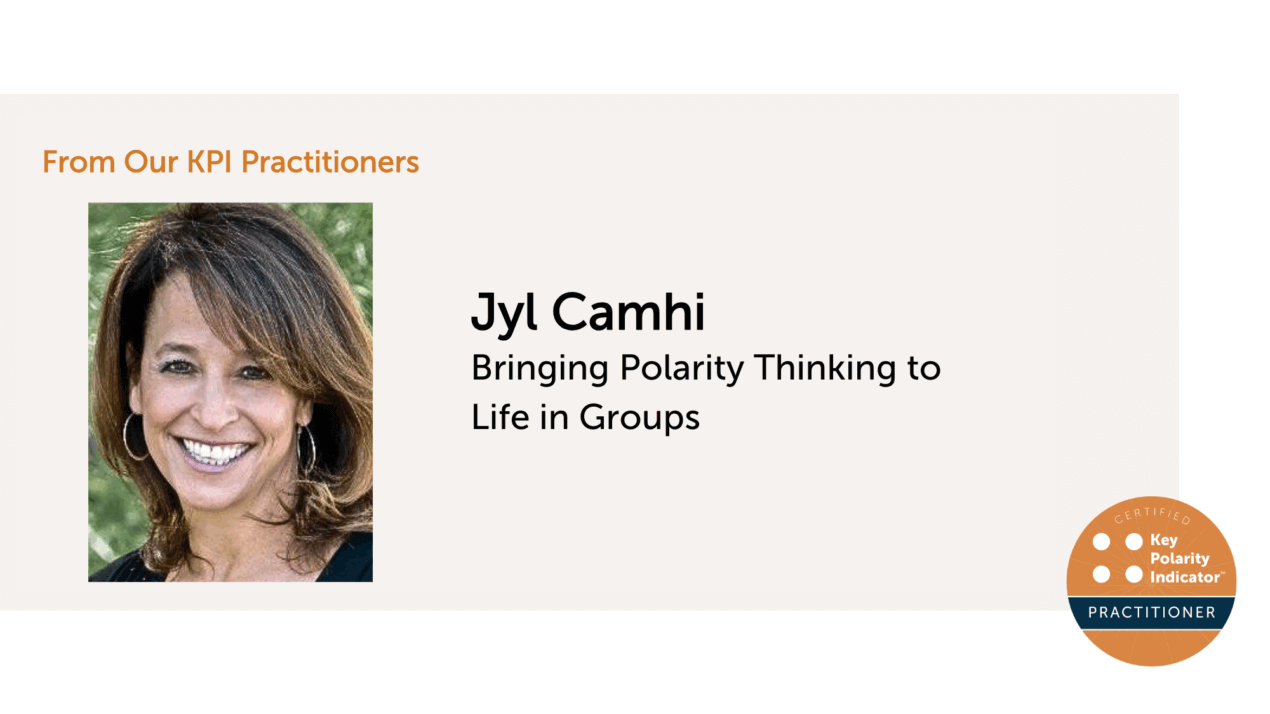
Jyl is passionate about guiding clients to develop authentic ways of working—achieving results with less frustration and more joy. A KPI Practitioner since 2021, Jyl shares how she is using the KPI and some tried and tested tips when working with groups.
Tell us about the work you do
Most of my work involves coaching, facilitation, and leadership development programmes – in all of these, I use polarities and, when possible, the KPI. Although I have worked with the KPI 360, my use of the KPI is predominantly with the KPI Self. The KPI makes it a much richer session than just working with polarity concepts alone.
Were you always interested in Polarities?
I first came across the work during our first 3-day class in Georgetown- it rocked my world and changed everything! It was wonderful. I don’t know how people coach without a strong understanding of these concepts. I think it’s foundational to coaching and human behaviour, and I wish the world had more of it.
I talk about these concepts all the time, even my kids know about it!
How do you use the KPI in your programs?
I use the KPI Self as part of a Leadership Development Program supporting succession planning at a Law firm. The KPI is a capstone for the 6-part program. We know a lot about participants by the time we work with the KPI, and it really helps them connect the dots with the tensions they are experiencing.
When introducing the KPI and teaching around it, I begin with the KPI Wheel to start a conversation about leadership – what it requires and the tensions that can show up. I don’t show them the model straight away-I have them come up with it. I start with what a leader does. We explore Vision, Delivery, and People based on what they already know. Getting them to think about what a leader does is critical, so they themselves will highlight the polarities mentioned- you don’t have to tell them. Then I explain how the key polarities fall into these responsibilities and the capabilities needed for each.
“The key is for them to understand the big picture- leadership is a collection of tensions.”
Before I share their KPI reports, we do an exercise where they think about where they naturally live when comes to a preference, inherently. We spend time creating a picture of this, and then we work with their data from the KPI report. I find this helps them to really connect to each of the Polarities and their data.
They pick one polarity to work with, and we move into an embodied exercise. It’s always so powerful to connect this back to the KPI Wheel before we finish. A 1:1 KPI Debrief follows the program so they can continue their exploration and refine how they will navigate the polarity over time.
“They love the session on Polarities, they are comparing notes and checking their data and they love the experiential nature of it. We get such great feedback on the session.”
Any tips for working with groups?
- Don’t let the KPI report drive you. Let the conversation leverage the report. Worry less about debriefing the report and more about understanding what they are saying and how it is showing up in the report. Keep double clicking with them to explore the behaviors, getting them the benefits and overuses of the poles.
- Relativity can feel like a hard concept to share initially – yet it really helps people to understand their KPI results, especially if there are lots of yellow in their report or they compare their results to their peers.
- I love bringing Embodied Practice into my work. It can be hard to do it at first to have the guts to do it. Now, I’d go as far as saying I will not do a polarity class without doing this. Such big Aha’s!
- As I work with a group, over a program, I create an Excel sheet– capturing each person and the 6 key polarities and populate based on what I am noticing and learning. They always choose the polarity to work on, and these observations shape our 1:1 coaching and can inform how we stack polarities to navigate over time.
- When coming up with a Third Way, I ask clients to identify a role model, a metaphor, or a phrase that would represent when they might do both of these things well and not get the overuses. I use sports analogies or athletes who embody both poles to guide.
Finally, a polarity you are working on
When I did my certification, Take Seriously::Hold Lightly showed up for me, and I was shocked. It was such a big eye-opener for me personally and something I have worked on ever since. I can be silly and fun, and when I’m in something, I can have an intensity. Now, I really try to keep that intensity in check and add some lightness. It was a huge learning experience for me. I sometimes call this polarity Effort and Ease.
Posted In: KPI Practitioner Exclusive